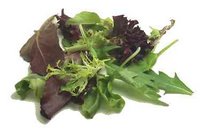Building a Better Salad
 If you're like me, eating salad every day gets old quick. No matter how resolved you might be to eat better, after a week or so, eating those greens with a few tomatoes and cucumber dressed with some reduced fat or fat free product get to you. You'd like something a little more...substantial. What are your options without completely falling off the wagon?
If you're like me, eating salad every day gets old quick. No matter how resolved you might be to eat better, after a week or so, eating those greens with a few tomatoes and cucumber dressed with some reduced fat or fat free product get to you. You'd like something a little more...substantial. What are your options without completely falling off the wagon?An article this week on kitsapsun.com gives you some suggestions and tips for improving that salad of yours.
The author tells you to forget you've ever heard of iceberg lettuce. Instead go for some of the more vibrant leaves:
To make a great salad, try to create a balance of mild, piquant, bitter or astringent, and peppery or spicy flavors. Try a butterhead such as Boston or bibb or a red or green leaf lettuce for the sweet taste. Add mustard greens such as mizuna or tatsoi for a piquant taste, add radicchio, escarole or curly endive for a bitter or astringent taste, and add arugula or watercress to get that peppery or spicy flavor.
So there's your lettuce, what about the rest of the salad? Here are some more suggestions:
Garbanzo beans, sunflower seeds, walnuts, hard-boiled eggs and leftover chicken, steak or tuna add protein and other nutrients, and cheese adds both protein and calcium. Tomatoes contribute vitamin C and lycopene, as do green, red or yellow peppers, which also contain vitamin A and other antioxidants.
And, of course, fresh herbs such as basil, oregano, chives and dill can brighten vinaigrettes and other dressings, although herbs and garlic should be strained out after a day or so to prevent development of an acrid taste if the vinaigrette is to be kept in the refrigerator for several more days.
If you are using fragile ingredients, such as hard-boiled eggs, bean sprouts or avocado, add them after tossing the salad and just before serving, or you will mix them into a mush.
A week's worth of more durable ingredients - such as meat, cheese, radishes, peppers and carrots - can be sliced or grated ahead of time and kept refrigerated to make packing a salad for lunch a faster and easier job. I also use only cherry or grape tomatoes in packed-lunch salads, to prevent the accidental creation of a batch of gazpacho in my salad container.
The article ends up with some more seasoning tips, and also has a couple salad recipes.

